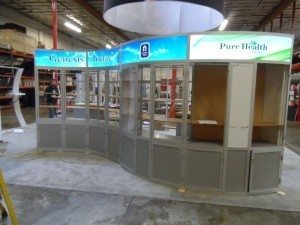Exhibiting 101: Post Trade Show Analysis
This is the eighth in a series of articles about the basics of exhibiting that began with the first post of the New Year.
Let’s face it. Producing a post-show evaluation isn’t much fun. It feels like doing your taxes, and it involves math. But it’s critical to the success of your trade show exhibiting program, so let’s try to simplify and de-mystify the process.
You won’t necessarily create your evaluation in this order. However, each of these points needs to have a place in your report.
1. Executive Summary:
People in the C-suite aren’t really that interested in how your trade show booth performed or how effective your graphics were. They’re looking at trade shows as part of a larger selling machine. You want to give them small chunks of information about your goals and objectives, post-show results, and all the other topics we’ll cover later in more detail.
Since this might be the only part of your report that really gets read, it has to include all the facts and figures that support the success of your event, or action steps to show how it will improve in the future. You may find it helpful to answer these questions:
– what worked?
– what didn’t?
– how successful were we in relationship to our competitors?
– was this the right show for us?
– what was the most valuable part of the show?
– what was the least valuable part of the show?
– was our location good?
– were our graphics successful in delivering the right message?
– does anything need to change before the next show?
2. Goals and Objectives:
Your goals could include:
– generating leads
– meeting with customers
– closing sales
– demonstrating products
– increasing brand awareness
– distributing samples
– building your social media following
– garnering press coverage
…and the list could go on and on.
If you were successful with these objectives, then you might want to highlight those results and share credit with members of your team. If you didn’t reach your goals, suggest revised tactics to help your team get there next time.
3. Lead Analysis:
About here is where most peoples’ eyes start to glaze over. But this is so important to improving your trade show program. And much of the work of it may have already been done.
First, separate your leads by category (Hot, Warm, Cold; A, B, C or whatever works for your sales staff. This should have been done during the show, as each trade show booth staffer concluded his or her interaction with a visitor.
Determine your follow-up plan for each category. You can then calculate your cost per lead by dividing the expenses related to your trade show participation into the number of qualified leads you collected. Include feedback from booth staffers, as well. Tracking follow-up results enables you to determine how many leads were converted to customers, and the revenue generated as a result.
4. Media Results:
How much media attention did your booth garner? Identify press, financial and industry representatives who came to the booth or your event, or met with your on-site press person. Compare this media coverage with what similar coverage would have cost in media buys.
5. Exhibit Effectiveness:
Your full report should include a description of your exhibit, and an evaluation of its effectiveness. If possible, include photos of any pertinent issues you’ll bring up (i.e.: damage to the exhibit). Discuss each of these areas:
– the trade show display itself
– product displays
– product demo area(s)
– trade show booth layout and traffic flow
– location on the exhibit hall floor
– graphics
6. Booth Staff:
Your booth staff needs to be evaluated, so you will know if changes or improvements need to be made prior to the next show on your calendar. You need to know:
– did you have enough staffers throughout the show?
– were the staffers effective in their duties?
– is booth staff training warranted for our next show?
– what worked and what didn’t, as far as people were concerned?
– who were the outstanding staffers you want to give special credit?
7. Budget:
This section should compare your actual spending to your original budget. Identify everything you did to keep spending under control. If there were significant overages, explain why they happened and what could be done next time to keep costs under control.
8. Conclusion:
Your pain is almost over. This is the last section of the report, and it simply compares this show with the rest of your trade show marketing program, past and future.
If you can, offer a year-to-year comparison of the results from this same show last year. Explain how the most recent show did better or worse in comparison to last year’s. Also explain why this was so, and how you can continue to succeed or make improvements in the future.
That’s all there is to it. Your post-show evaluation is done. You now know more about your trade show program, more about your exhibit, more about your competitors, and more about what you want to do next time.
And all that information is in a format that can be shared with everyone who needs to know about it at your company. And one more thing: share it with your exhibit provider. They want to help, and knowing what you want to accomplish will allow them to help you more. But if your exhibit supplier isn’t interested in your report, talk with us. Call (800) 676-3976 or email [email protected].
For more, learn about promoting your presence or the etiquette of working trade shows.
See the full list of Exhibiting 101 articles here.


